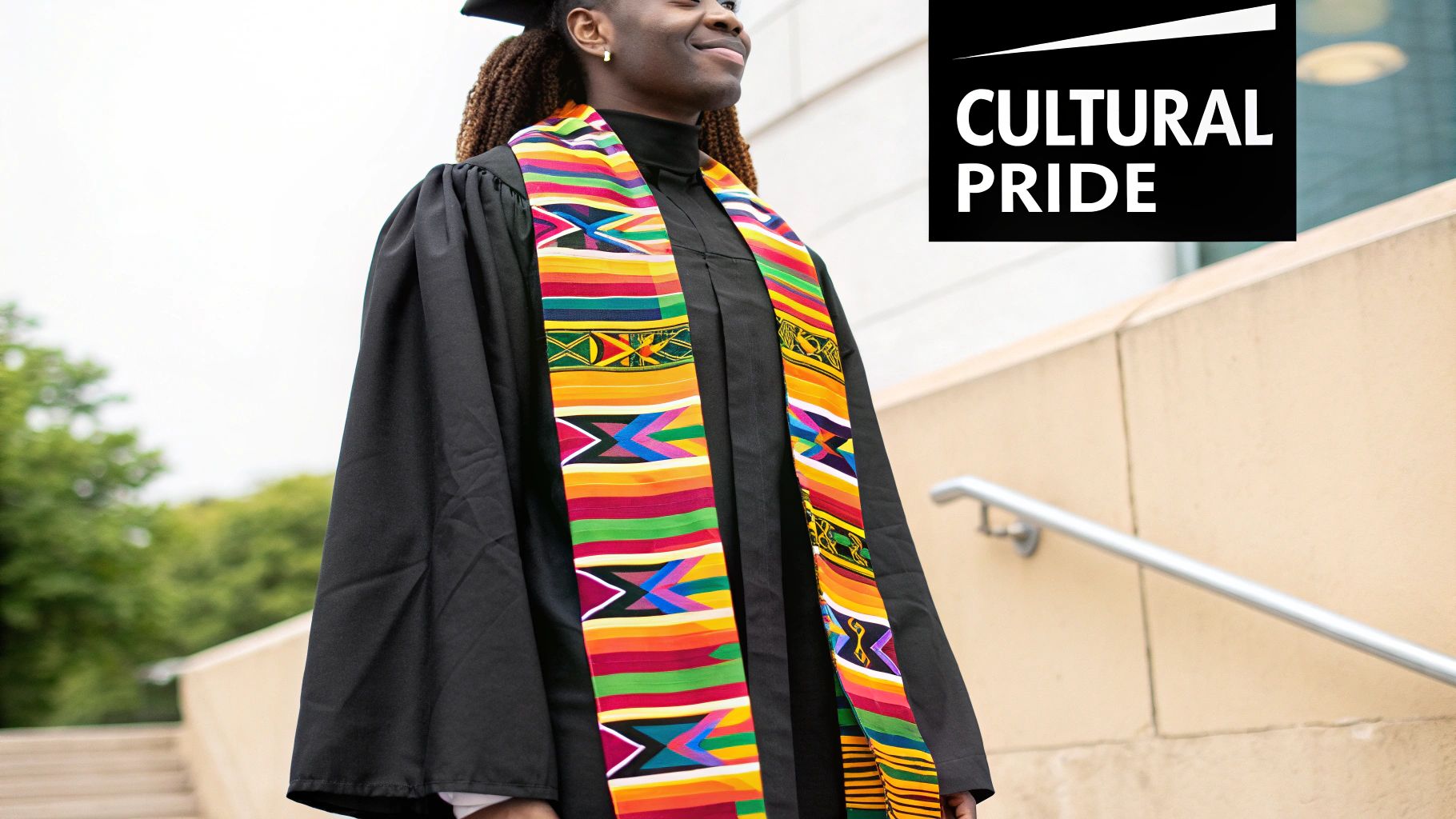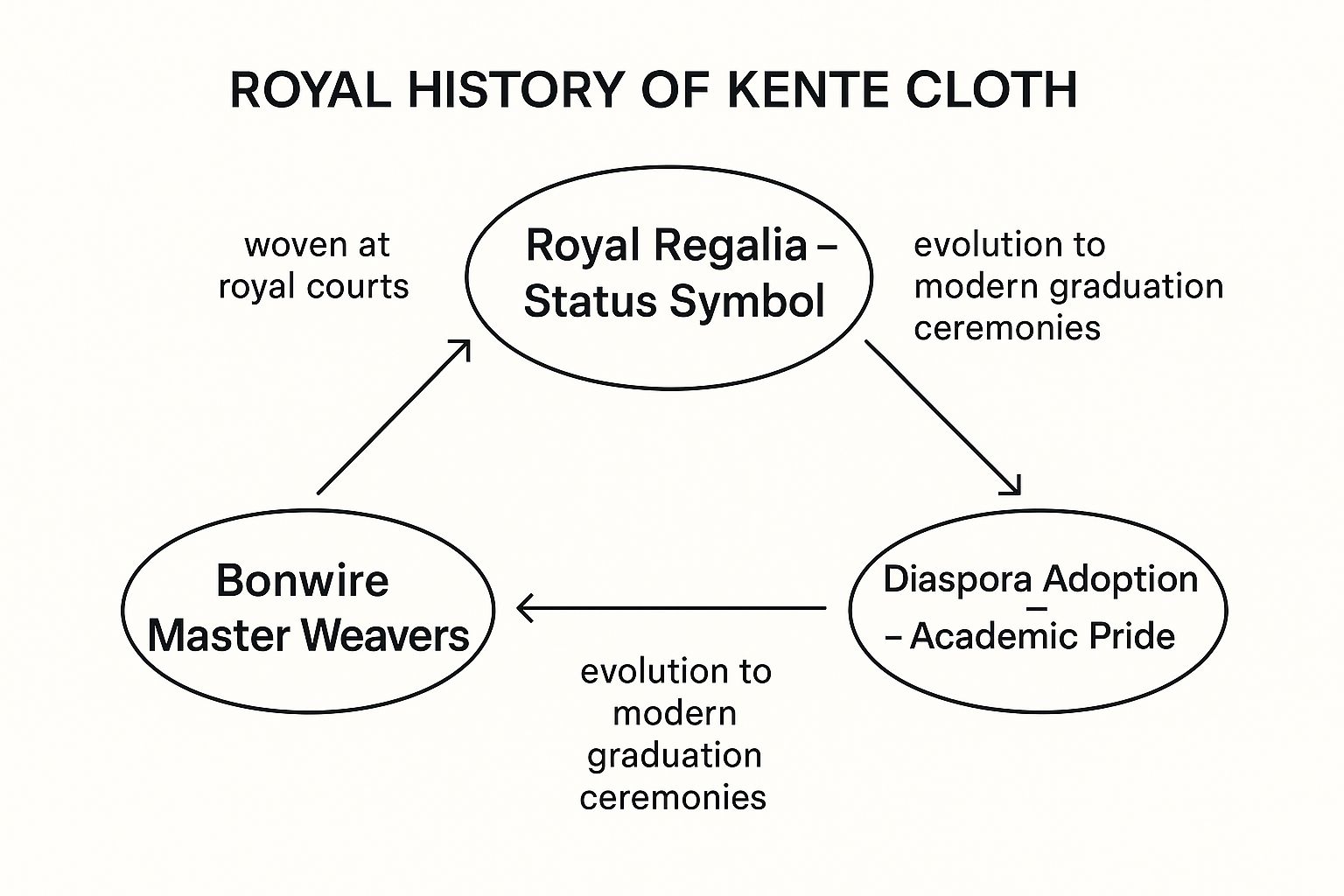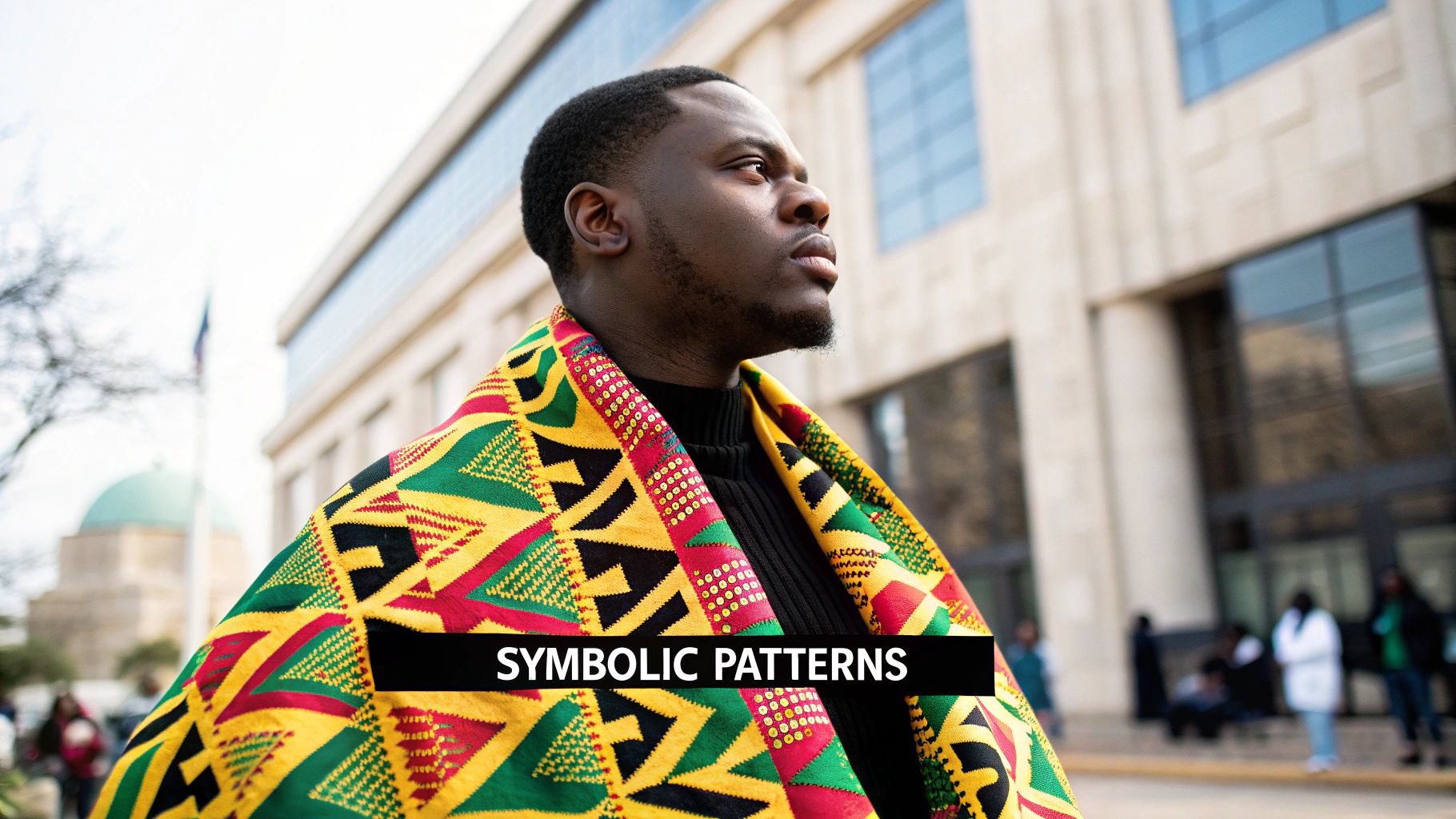When you see a Kente stole at a graduation ceremony, you're looking at much more than a colorful piece of fabric. It's a powerful, wearable symbol of achievement, heritage, and pride. Born from the incredible weaving traditions of Ghana, every stole tells a unique story through its patterns and colors, tying the wearer’s personal success to a deep and vibrant West African legacy.
A Symbol of Success and Identity

At its heart, a Kente stole is a story you can wear. Don't just think of it as part of the cap and gown; see it as a prestigious emblem that celebrates the graduate's hard work and success. It's become a meaningful and widespread tradition at academic ceremonies, particularly within the African diaspora.
For many graduates, putting on a Kente stole is a profound act. It's a visual declaration of the years of effort they've poured into their education, while also honoring the ancestors and cultural history that made their journey possible. This single piece of cloth beautifully connects the past and the present, celebrating both a personal milestone and a shared identity.
Kente Stole at a Glance
To really get what a Kente stole is all about, it helps to look at its core components. The stole is packed with history and meaning that go far beyond its stunning looks. This table gives you a quick snapshot of where it comes from, what it represents, and how it's used today.
| Attribute | Description |
|---|---|
| Origin | Derived from the traditional Kente cloth of the Ashanti and Ewe peoples in Ghana, West Africa. |
| Primary Meaning | A symbol of academic achievement, personal success, and cultural pride. |
| Common Use | Worn over the shoulders during graduation ceremonies and other significant rites of passage. |
| Key Characteristic | Features vibrant, meaningful patterns and colors that communicate specific values and stories. |
As you can see, every element—from its roots in West Africa to its modern role in graduation—contributes to the stole's powerful significance. It's a tradition that carries immense weight and beauty.
The Royal History Woven into Kente Cloth
To really understand why a kente stole is so much more than just a piece of graduation regalia, you have to travel back to 17th-century Ghana and the royal courts of the Ashanti Kingdom. This wasn't a fabric for just anyone. Kente was originally created exclusively for kings, queens, and the most respected members of society, acting as a bold symbol of their incredible wealth, high status, and divine right to rule.
Legend traces its beginnings to a pair of hunters who supposedly learned the art of weaving by watching a spider meticulously spin its web. This story isn't just a quaint folktale; it highlights the deep bond between kente, the natural world, and true craftsmanship.
From Royalty to Global Recognition
The art form was perfected in the town of Bonwire, where master weavers developed the complex patterns and unique techniques that we recognize as kente today. These artisans passed their skills down from one generation to the next, making sure the tradition didn't just survive but thrived as a pillar of Ghanaian culture.
Kente is more than just cloth; it is a visual representation of history, philosophy, ethics, oral literature, religious belief, social values, and political thought. Each design has a story, a proverb, or a historical event attached to it.
That kente stole you see at graduation ceremonies is a direct link to this royal fabric, now a globally recognized symbol of African heritage and achievement. Kente's roots are firmly planted in the 17th-century Ashanti Kingdom, where weavers created its signature designs by hand on specialized looms. Even today, over 80% of handmade kente is still produced in Ghana, carrying on a tradition that has stood the test of time. You can learn more about kente’s incredible journey on Zedighana.com.
This infographic breaks down the evolution of kente from its regal origins to its modern-day importance in the world of academia.

As you can see, what was once a symbol of royal status has transformed into a powerful emblem of academic pride, especially for the African diaspora. This amazing shift started in the late 20th century when African American students and universities adopted the kente stole. For them, it became a powerful sign of cultural identity and resilience during graduation, kickstarting a new tradition packed with historical meaning.
Decoding the Language of Kente Colors and Patterns
Every single thread woven into a kente stole tells a story. These aren't just random, pretty designs; the colors and patterns are a rich visual language, carefully chosen to communicate ideas, values, and even proverbs straight from Ghanaian culture. To truly understand what a kente stole is, you have to learn how to read this vibrant narrative.

Think of it less like a piece of clothing and more like a wearable piece of art that tells a story. Each color carries a specific symbolic weight, turning the fabric into a canvas of meaning. This beautiful tradition allows the wearer to send a powerful message without ever saying a word.
The Symbolism of Key Colors
The colors chosen for a kente stole are the key to its core message. While there can be slight variations in interpretation, certain meanings are widely recognized and deeply rooted in Ashanti tradition.
Take a look at what some of the most common colors represent:
| The Meaning Behind Kente Colors | ||
|---|---|---|
| Color | Symbolic Meaning | Represents |
| Gold (or Yellow) | Royalty, Wealth, Status | Spiritual Purity, Preciousness |
| Green | Growth, New Beginnings, Renewal | Prosperity, Life, Harmony |
| Black | Maturity, Spiritual Strength | Connection to Ancestors, Resilience |
| Blue | Peace, Serenity, Love | Harmony, Togetherness |
| Red | Passion, Political Action | Spiritual Moods, Sacrifice |
| White | Purity, Sanctification | Innocence, Festivities |
| Purple | Femininity, Wisdom | Royalty, Healing, Protection |
As you can see, the palette is deeply intentional. Of course, this is just a starting point. To truly appreciate the artistry, you can explore a more detailed breakdown of kente cloth meaning and symbolism in our other guides.
A kente stole is a visual representation of history, philosophy, and personal achievement. The colors are not merely aesthetic; they are the very essence of the story being told, connecting the wearer to a legacy of wisdom and strength.
Reading the Woven Patterns
Just as the colors have meaning, so do the intricate geometric patterns woven into the fabric. These designs aren't abstract; they often have specific names and are tied to historical events, core values, or philosophical ideas. A particular pattern might represent the importance of unity, the strength of family, or the wisdom of elders.
When you see all these elements combined, you're looking at a powerful form of communication. A stole featuring gold and green might tell a story of a prosperous new beginning rooted in a royal legacy. One with black and red could speak of passionate strength drawn from spiritual maturity. This is what makes each kente stole a deeply personal and meaningful emblem of a graduate's journey.
From Ghanaian Looms to Global Graduation Stages
The journey of a kente stole doesn't start in a factory. It begins in the hands of a skilled artisan in Ghana, following a meticulous, time-honored weaving process. Every authentic stole is a direct link to the cultural heritage and the very livelihood of its creator.
This is a world away from mass-produced imitations that lack the rich texture, deep history, and unique story woven into every hand-made piece. When you hold a genuine kente stole, you're holding a connection to a Ghanaian weaver whose craft supports their family and community.
Economic and Cultural Preservation
The kente industry is a cornerstone of Ghana's cultural export economy. It's a source of immense national pride and supports thousands of families, with traditional textiles like kente bringing in over $30 million in annual revenue.
This vibrant trade, fueled by global demand, provides direct jobs for about 5,000 weavers and supports another 10,000 people in related roles. You can learn more about this powerful economic impact on MemoryCherish.com.
Choosing an authentic, handwoven kente stole is more than a purchase; it's an investment in cultural preservation. It ensures that the intricate art of kente weaving continues to be passed down through generations, empowering artisans and sustaining a rich tradition.
As e-commerce connects these artisans with a worldwide audience, the tradition doesn't just survive—it thrives. This allows graduates everywhere to celebrate their own milestones while honoring the stole's proud Ghanaian roots. Understanding who wears kente stoles and why only deepens the appreciation for this powerful symbol.
The premium price of an authentic stole reflects its true value: hours of skilled labor and a real commitment to cultural authenticity.
How to Choose and Wear Your Stole with Respect
Picking out a Kente stole isn't just another piece of graduation attire—it's about connecting with and honoring a deep, vibrant heritage. The first thing you'll want to do is learn how to spot an authentic, handwoven stole versus a mass-produced print. A real Kente stole has a substantial, thick texture you can feel, and if you flip it over, you'll see a web of loose threads. That's the signature of a hand-operated loom.
Printed knock-offs, on the other hand, usually feel flat and are smooth on both sides. To make sure your purchase truly matters, look for sellers who source their stoles directly from weavers in Ghana. This way, you get a genuine piece of cultural art, and you're supporting the artisans who keep this tradition alive. If you're ready to find the perfect one, you can browse a beautiful selection of authentic Kente graduation stoles to discover a design that truly resonates with you.

Wearing Your Stole with Honor
Once you have your stole, wearing it correctly is the final piece of showing respect for its meaning. It's simple: just drape it evenly over your shoulders so that both ends hang parallel down the front of your graduation gown. You'll want to avoid pinning it in a way that bunches up the fabric or hides those incredible, intricate patterns.
The act of wearing a Kente stole is a declaration of pride in your academic journey and a tribute to the legacy of resilience and creativity it represents. Handle it not as an accessory, but as the symbol of honor it is.
The difference in craftsmanship is truly staggering. In Ghana, weavers create the cloth in long, narrow strips which are then meticulously sewn together. Think about this: a single handwoven stole can take up to a week to complete, while a factory can print 1,000 versions in a single day for a tiny fraction of the cost. You can learn more about this incredible traditional weaving process on Wikipedia. Knowing the skill and time involved helps you fully appreciate the value of what you're wearing.
Frequently Asked Questions About Kente Stoles
As Kente stoles have become a more visible and celebrated part of graduation, it's natural to have questions about their history, meaning, and how to wear them properly. Getting the right information is the key to honoring this powerful symbol with the respect it deserves.
Think of this as your quick guide to engaging with the Kente tradition in a thoughtful and informed way, covering everything from cultural etiquette to practical tips on care.
Can Anyone Wear a Kente Stole for Graduation?
This is probably the most common—and most important—question people ask. While the Kente stole has deep roots in Black and African heritage, its embrace has grown. Today, many see it as a powerful symbol of solidarity, achievement, and honor that allies can wear with respect.
The most critical factor here is intention. If you choose to wear one, it’s vital to understand its significance as a symbol of Black excellence and resilience. It's not just another piece of academic regalia; it's a meaningful tribute to the culture it comes from.
Wearing a Kente stole is an act of celebration and acknowledgment. When worn with genuine respect for its origins and meaning, it honors the legacy of achievement it represents for all graduates.
How Can I Tell if a Kente Stole Is Authentic?
Spotting a genuine Kente stole versus a mass-produced imitation is easier than you might think, once you know what to look for. An authentic, handwoven Kente stole feels substantial and has a distinct texture. That’s because it’s crafted from several narrow strips of cloth that are meticulously woven and then sewn together.
The biggest giveaway? Flip it over. A real Kente stole will have a messy web of loose threads on the back—a natural byproduct of the hand-weaving process. A printed replica will be smooth on both sides, often made of a flimsy polyester, and feel much lighter.
Can I Customize My Kente Stole?
Absolutely! Customization is a fantastic way to make your stole a true reflection of your personal journey and achievements. Many sellers, especially those with direct connections to Ghanaian artisans, offer embroidery to add those personal details.
Some popular customizations include:
- Your name and graduation year
- Your degree or major (e.g., "B.S. Nursing")
- Fraternity or sorority letters
- Meaningful adinkra symbols that resonate with your story
This kind of personalization transforms your stole from a symbol of a milestone into a cherished keepsake that tells your unique academic story.
How Should I Care for My Kente Stole?
To keep your Kente stole looking beautiful for years to come, proper care is a must. Machine washing is a definite no-go, as it can easily damage the delicate threads and cause the vibrant colors to fade.
Instead, your best bet is to gently hand-wash it in cold water with a mild detergent. Alternatively, you can have it professionally dry-cleaned. To dry, lay it flat or hang it up, but keep it out of direct sunlight. Storing it in a cool, dry place will preserve its beauty for a lifetime.
Ready to celebrate your achievement with a symbol of heritage and pride? At Stoles.com®, we offer a stunning collection of authentic, customizable Kente stoles that honor this rich tradition. Find the perfect design to tell your story and wear your success with honor. Explore our collection today at https://www.stoles.com.


